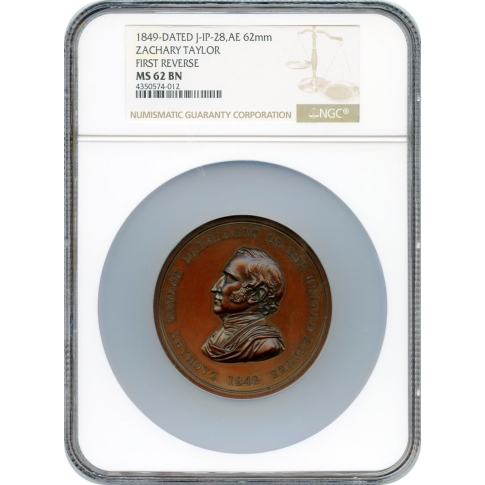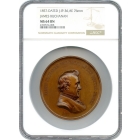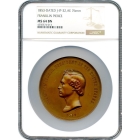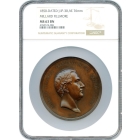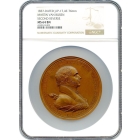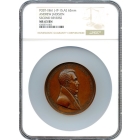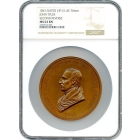Indian Peace Medal - 1849 Zachary Taylor, J-IP-28 First Reverse AE 62mm NGC MS62
Peace Medals were instrumental in building relationships with the various Indian Tribes. American Presidents (and their Colonial predecessors) used Indian Peace Medals as a way of placating various tribes and/or to build alliances with them. The recipients valued them highly, for they conferred a prestige that was recognized throughout the nation. The Bureau of Indian Affairs considered them crucial and the Presidents for whom they were issued also knew their importance. Many images from the "Old West" show Indians proudly wearing their Peace Medals (sometimes more than one). Generally, bronze medals were not used for presentation purposes, but in some cases, they were silver-plated and either given, sold, or traded away by unscrupulous individuals to unwitting recipients.
NGC total census of only 1 medal as 62mm - the present example. There are 2 certified as Gem Brilliant Uncirculated under the 62.5mm variety.
Zachary Taylor Indian Peace Medals
The creation of the obverse dies for the Zachary Taylor IPMs was a convoluted affair. Initially, William Medill, Commissioner of Indian Affairs, wrote to Mint Director Patterson, to ask if the likeness of Taylor, the hero of the Mexican War, from military medals, or even if the actual die itself from a war medal, could be used as the obverse of the Taylor IPM. Patterson said that the original die could indeed be used. But Medill also wrote to John G. Chapman, who modeled the bust of President Polk for his IPM, to see if he would be available to create a bust of Taylor. The Secretary of the Interior also became involved, first wanting the die from the war medal to be used, and then changing his mind to having a new likeness created. Chapman was in Europe, and therefore Henry Kirke Brown was recommended.
Brown was selected to create the image of Zachary Taylor, and traveled to Washington to sketch the president. By June 1, 1849, Brown had completed the medallion and he then sent it to Franklin Peale, Chief Coiner at the Mint. However, there were problems with the work, and Brown had to travel to Philadelphia to meet with Peale to be instructed on how to craft it properly. Brown executed a new version that met with Peale's requirements. There was a delay, for it was not until September 25 that Peale wrote to Orlando Brown, the new Commissioner of Indian Affairs, to tell him that the dies were being produced.
New reverse dies needed to be created. The original dies made by John Reich, which had been used on every IPM since Madison's, were determined to no longer be usable. On December 5, 1849, it was reported that new reverse dies had been finished. All the work on the new dies was needed because of bad timing. Every medal after Taylor's had unique reverses created specifically for them.
There was an urgent appeal from the Indian Office to receive the medals. Peale and his workmen did all they could to get as many medals shipped out as possible. Over the course of months, the Mint shipped a few hundred Taylor medals to the Indian Office. Orlando Brown had quite a collection of IPMs for himself and the his Indian agents to present to the Indians. However, on July 9, 1850, President Taylor passed away, thus the medals carrying his image were useless. Of the 396 medals struck, 307 had not been distributed to the Indians, and they were melted down to produce the Millard Fillmore medals.
Zachary Taylor and the Indians
Taylor was a US army major during the War of 1812, when he battled the British and the Shawnee. It was during the Black Hawk War (1832) and the Second Seminole War from 1837 to 1840 that he fought for Indian removal. While fighting the Seminoles, he asked for permission to use bloodhounds to locate Indians in the swamps of Florida. He wrote, "I am decidedly in favor of the measure, and beg leave to urge it as the only means of ridding the country of the Indians, who are now broken up into small parties that take shelter in swamps and [hammocks], making it impossible for us to follow or overtake them without the aid of such auxiliaries. I wish it distinctly understood, that my object in employing dogs, is only to ascertain where the Indians can be found, not to worry them." The Florida legislature authorized the use of dogs, sending 33 of them with five handlers. The dogs were trained to locate the scent of black slaves, however, and were therefore useless in finding Indians.
Taylor, who served as president for just 16 months, died in July 1850 at 65 of cholera or gastroenteritis from tainted food. While president, he pushed for both assimilation and removal of the Indians. Taylor enlarged the reservation system, hoping that "confined Indians" would embrace Western culture and agriculture.
Zachary Taylor Indian Peace Medals for Indians and Collectors
Dated 1849, all original Taylor IPMs were struck on solid silver planchets. They were produced in three sizes: 76 mm, 62 mm, and 51 mm. The medium-sized medal (62 mm) was generally sold to the public after 1860.
| Grading Service | NONE |
|---|---|
| Year of Issue | NONE |
| Grade | NONE |
| Denom Type | N/A |
| Numeric Denomination | Medal |
| Mint Location | NONE |
| Designation | NONE |
| Circ/UnCirc | Not Specified |
| Strike Type | N/A |
| Holder Variety | Zachary Taylor: J-IP-28, AE, 62mm First Reverse |
| Grade Add On | NONE |
| Holder Type | N/A |

